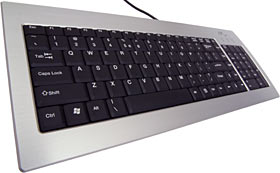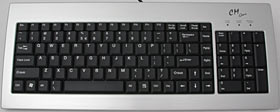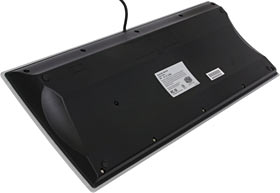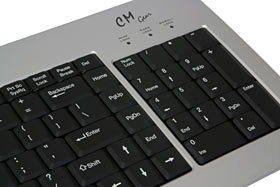
Cooler Master EAK-US1 keyboard
Review date: 9 August 2003.Last modified 03-Dec-2011.
Do you want a stylish keyboard? Do you want black keys? Do you want a subtly curved brushed aluminium frame around those keys? Do you still want a proper numeric keypad?
Then maybe you want this.
Cooler Master's EAK-US1 is, in essence, a large laptop computer keyboard, packaged up for ordinary cabled-keyboard use. It's got a full complement of keys (none of them emulated by awkward "Fn" key combinations), built into a natty aluminium-topped casing with a USB cable (USB only, no PS/2 adapter). And it also has a non-ridiculous price tag.
Here in Australia, Aus PC Market sell the EAK-US1 for $AU78.10 including Australian delivery. That's more than twice what you'll pay for a basic 104 key 'board (the EAK-US1 has 104 keys, but not quite in the usual layout). But it's cheaper than a lot of fancy "multimedia" keyboards with numerous little extra buttons of questionable value.
(And yes, I know you can pay a lot less than $AU40-odd for a keyboard. But a $AU9.95 'board from your local discount store is likely to only be suitable for punishing LAN party visitors who managed to forget their own 'board.)
Cooler Master helpfully, and accurately, specify the EAK-US1's dimensions down to the half-millimetre. It's 414mm wide (the average 19 inch monitor's likely to be about 430mm wide, for comparison) by 166.5mm deep, by 28mm tall at its highest point. It weighs about 720 grams, depending on how much of its cable you include in the equation.
This is around the same weight as an ordinary 104 key plastic keyboard, but the EAK-US1 is a bit smaller. Regular full-sized PC keyboards are about 460mm wide; big ones can be 490mm.
(For reference, the battleship buckling spring IBM keyboards I like weigh around two kilograms.)
Cooler Master's promise (or, perhaps, request) on the EAK-US1 packaging that you "style up your life" doesn't bode well for this keyboard's practicality. I checked out the Musketeer, another triumph of style over substance from the Cooler Master stable, the other day.
Is the EAK-US1 another vaguely useful, mainly decorative product?
Trying it out
The layout of the EAK-US1 isn't particularly bizarre. It's mildly compressed, with the usual laptop-keyboard reduced-size function key row, but the major keys are all where you expect them to be.
The Enter and backslash keys have the traditional IBM layout (rectangular Enter with backslash above it, rather than L-shaped Enter with backslash somewhere else), but there's a second backslash to the left of the space bar. The Del/Home/PgUp/PgDn/End keys are squished into a vertical row at the right edge of the main key block, the cursor keys are at the bottom right corner of that block, and Insert's to the left of the left-arrow cursor key, but that's about it for layout weirdness. The numeric keypad's layout is normal, even if its location isn't.
On the other side, there's very little to report. Four rubber feet and some sculpted black plastic. And, notably, no little fold-down stands. The EAK-US1 will tilt slightly towards you naturally, but if you want to tilt it more (as many people do), then you're going to have to put something under its back feet.
You may have to do that anyway. I found the EAK-US1 I got for review wasn't quite flat. Put on a flat desk, it rocked slightly diagonally. The four rubber feet were all correctly seated; it was the body of the keyboard itself that was a little warped.
I shimmed one corner with a folded piece of paper for reviewing purposes, and it isn't hard to use something self-adhesive to fix this sort of problem in a more permanent way. It shouldn't need fixing in the first place, though.
To type on, the EAK-US1 feels like a cheap laptop keyboard, because that's what it is. Well, OK; this exact keyboard module would probably only be used in a relatively pricey "aircraft carrier" stacked multimedia laptop with a 17 inch screen; it's too wide for a 15 incher. But keypad-free 'boards with these same keyswitches are standard issue for entry level notebooks.
The EAK-US1's key travel is very short, and the keys have very little tactile feedback. It's also not whisper quiet. There's a hollow resonance from the body of the keyboard, to start with - and the keys you're pressing at any given moment won't make much noise, but all of the other keys will rattle around a bit with every keypress. Many cheap keyboards are like this, but cheap laptop keyboards sound the worst.
Even with the loose-keys buzz, though, the EAK-US1 isn't loud. Certainly not compared with a buckling spring IBM 'board. Buckling spring keyswitches alert the whole office to your typing, and also make you sound as if you're working twice as fast as you actually are. I don't mind this. I'm a keyboard extrovert.
The EAK-US1's pretty much ruler flat in all directions. Its aluminium frame is curved, but the key assembly itself isn't. This is because laptop keyboards have to be flat, to take up as little room as possible between components below and screen above when the computer's lid is closed. Normal desktop keyboards, though, generally have some vertical concavity; the keys all point inwards to make them easier to reach. Not so here.
You can't rest either thumb on the EAK-US1's space bar, because all of the keys are practically flush with the aluminium surround. This stops you resting your hands on the surround in general. You're not meant to rest your hands on the keyboard surround anyway, though, unless you're not typing; it's ergonomically better to type with your hands held above the keys, and you should set up your chair and desk so you can do that with your forearms level.
The only real downside of the aluminium surround on the US1 is that it's chilly on cold days.
Overall
This keyboard isn't a nightmare. I wouldn't choose it, and I doubt anybody who does a great deal of typing would either, whether they're a member of the One True Buckling Spring Faith or not. But it feels no worse than a basic laptop keyboard, and people use those every day without their fingers falling off.
Cooler Master say the EAK-US1 is "suitable for long hour business usage"; well, OK, it may last for a long time even with heavy use (or it may not; my keyboard-testing 25,000 word per minute typing robot's in the shop at the moment, so I can't tell), but if you're hammering away all day, you'll be happier with a more conventional keyboard than this.
As usual when I'm reviewing keyboards, I felt great relief when I put this one to one side and went back to my heavyweight IBM 'board. That doesn't make the EAK-US1 a lousy product, though. It looks great, and it's reasonably well made; if it cost $AU200 then its rattly keys and instability would be unforgivable, but it's not terribly expensive. The EAK-US1 would be fine as a show-off keyboard for an Internet cafe, or on the reception desk at a business that's trying to look all swish and minimalist, or for a case modder who doesn't have the time to go all out.
A revolution in typing technology this ain't, but it does the job, and requires much less re-learning than some keyboards I've seen. If the EAK-US1's looks appeal to you, it's worth checking out.
Cooler Master's page for the EAK-US1
Buy one!
Readers from Australia or New Zealand can purchase the EAK-US1 from
Aus PC Market.
Click here!
(if you're NOT from Australia or New Zealand,
Aus PC Market won't deliver to you.)





